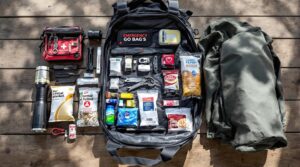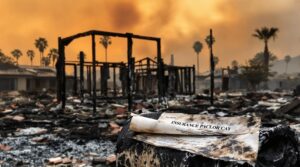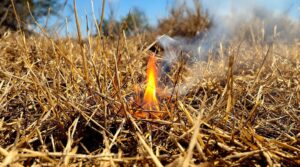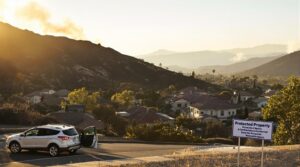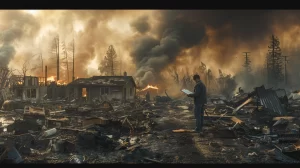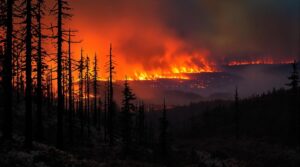To prevent wildfires and forest fires, employ defensible space techniques, prune trees for adequate spacing, and maintain low grass height. Confirm safe campfire practices by using designated fire pits and extinguishing fires fully. Dispose of cigarettes in non-flammable containers and follow fireworks regulations. Public education and community involvement enhance preventative measures. Technological solutions, like solar-powered sensors, aid early detection. Collaboration with authorities confirms resources are allocated effectively, revealing further strategies.
Key Takeaways
- Create defensible space by removing flammable vegetation and using fire-resistant landscaping materials around properties.
- Practice safe campfire habits by using designated fire pits and never leaving fires unattended.
- Dispose of cigarettes and matches properly in closed containers or extinguish them with water.
- Participate in community fire safety initiatives and workshops to enhance awareness and preparedness.
- Utilize technology such as sensors and algorithms for early wildfire detection and improved response times.
Understanding the Causes of Wildfires
When analyzing the causes of wildfires, it becomes evident that human activities account for nearly 90% of such incidents in the United States, a statistic underscoring the substantial role of anthropogenic factors in fire ignition. Unattended campfires, improperly discarded cigarettes, and equipment malfunctions are predominant contributors that can spark fires.
These incidents highlight the critical need for public education to prevent wildfires by fostering awareness and adherence to fire safety protocols.
Natural phenomena, although less frequent, also play a significant role in wildfire ignition. Dry lightning strikes, particularly during arid conditions, can ignite vegetation, while volcanic eruptions present another natural catalyst through the emission of hot debris and lava.
Understanding these multifaceted causes is paramount for developing strategic prevention and mitigation measures. By thoroughly addressing both human-induced and natural ignition sources, authorities can enhance preparedness and reduce the incidence of destructive wildfires in vulnerable regions.
Creating a defensible space zone around properties by maintaining a 30-foot buffer of cleared vegetation significantly reduces wildfire risks.
Creating Defensible Space Around Properties
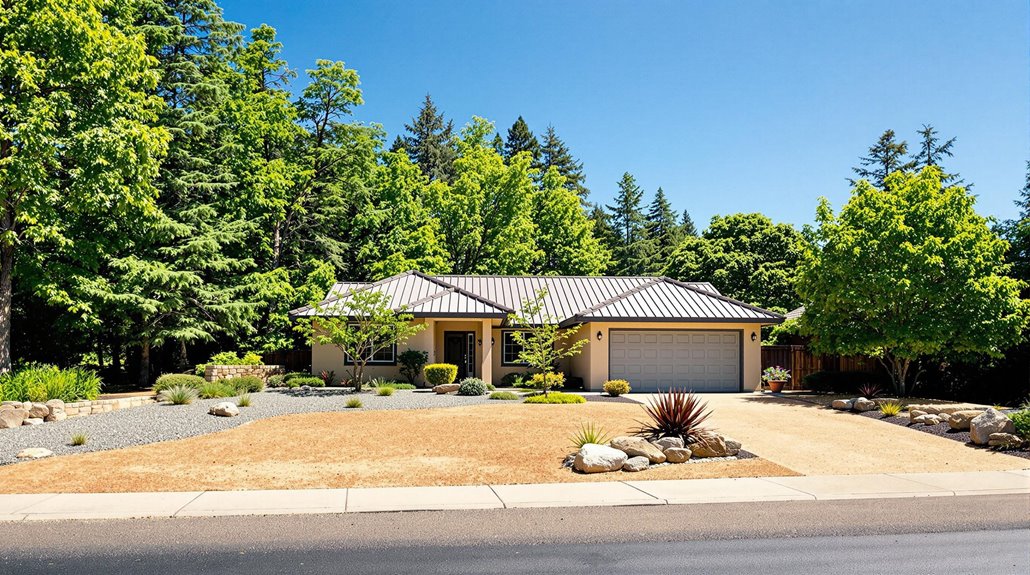
To mitigate the risk of wildfires encroaching on residential areas, creating a defensible space around properties is a critical strategy. This involves establishing a buffer of at least 30 feet by removing flammable vegetation, dead plant material, and debris, which can ignite during a wildfire event.
Implementing fire-resistant landscaping materials, such as rocks and gravel, can help prevent fires from spreading to structures, while low-growing plants minimize potential fuel sources.
Pruning trees to maintain a vertical spacing of at least 10 feet between the tops of shrubs and the lowest branches is essential to eliminate ladder fuels that facilitate fire escalation. Regular maintenance, including mowing grass to a maximum height of 4 inches and clearing dry leaves, considerably reduces available fire fuel.
Adhering to National Fire Protection Association (NFPA) guidelines by creating defensible space in phases—Zones 1, 2, and 3—systematically mitigates wildfire risk.
GIS technology plays a crucial role in assessing property vulnerability by analyzing vegetation, topography, and climate factors that influence wildfire risk.
Safe Campfire Practices
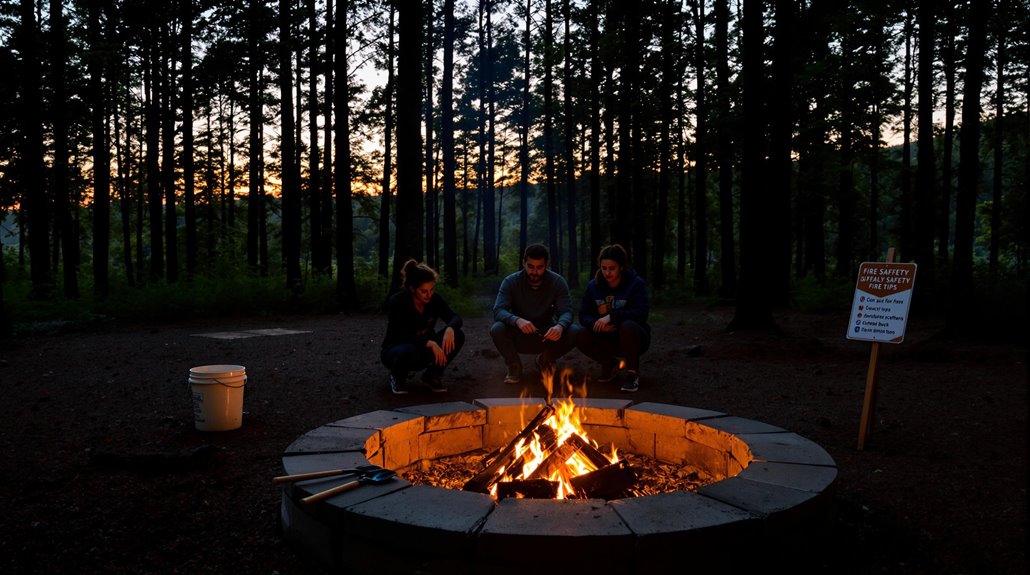
Engaging in safe campfire practices is essential to minimizing the risk of wildfires, particularly in vulnerable forested and grassland areas. Designated fire pits or campfire rings, cleared of vegetation and enclosed by rocks, serve as primary mitigative measures to prevent wildfires. This protocol is particularly important in regions prone to wildfires, such as California.
The dynamics of fire behavior underscore the necessity to never leave campfires unattended, as embers can ignite dry vegetation, propagating extensive fire spread. On windy days, the potential for embers to disseminate increases, requiring caution against starting campfires.
Proper extinguishment involves dousing flames with water and agitating ashes to confirm they are cool to the touch, thereby eliminating latent heat sources. Compliance with local regulations and obtaining requisite permits further enhances safety. Awareness of these practices, coupled with proper handling of equipment and vehicles, is indispensable in curtailing wildfire incidences within natural habitats.
Proper Disposal of Cigarettes and Matches

Proper disposal of cigarettes and matches is a critical component in wildfire prevention, as improperly discarded smoking materials account for a significant proportion of ignition sources.
It is essential to utilize closed containers or water to guarantee complete extinguishment of these items, thereby mitigating the risk of igniting dry vegetation.
Additionally, public awareness and adherence to local fire safety regulations play an essential role in reducing the incidence of fires caused by human negligence.
Safe Disposal Methods
Effective prevention of wildfires necessitates meticulous attention to the disposal of smoking materials such as cigarettes and matches. Implementing robust cigarette disposal methods is essential.
Cigarette butts and matches should be deposited in closed containers or submerged in water to avoid igniting flammable materials. Adhering to smoking area guidelines can greatly mitigate fire risks. Designated smoking zones should be devoid of combustible materials and equipped with appropriate disposal units. Understanding wind conditions is important, as embers can be transported to susceptible regions.
Key safe disposal strategies include:
- Utilize closed containers for disposing of cigarette waste.
- Avoid discarding in areas with dry vegetation.
- Ensure smoking areas are free of flammable material.
- Educate individuals on proper flammable material storage.
Fire Hazard Awareness
Understanding the critical role of proper disposal practices in fire hazard prevention is essential, given that nearly 90% of wildfires in the United States result from human actions.
The act of discarding cigarettes and matches improperly can dramatically alter fire behavior, particularly in regions with dry vegetation.
Vegetation management is fundamental in these areas, as embers from smoking materials can ignite flammable materials, escalating into large-scale wildfires.
Conducting a risk assessment highlights the importance of utilizing designated containers for cigarette and match disposal.
Smokers are advised to employ portable ashtrays, especially in high-risk fire zones, ensuring that smoking remnants are completely extinguished.
Enhancing public education on these practices can mitigate the occurrence of human-induced wildfires, fostering a safer environment.
Fireworks Safety and Regulations
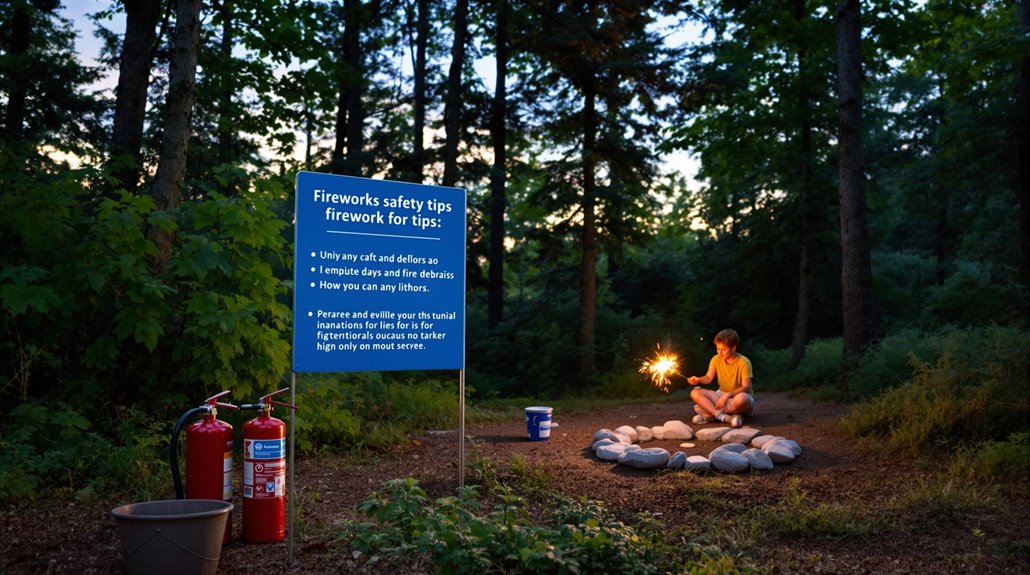
Fireworks safety and regulations present a complex tapestry of legal distinctions and safety protocols essential for wildfire prevention.
Fireworks regulations differ markedly across jurisdictions, with some areas permitting only "Safe and Sane" fireworks, while others enforce complete bans due to intrinsic fireworks hazards.
This multifaceted regulatory landscape necessitates careful examination of local laws to prevent legal repercussions and mitigate fire risks.
The following methodological guidelines offer an extensive framework for safe fireworks utilization:
- Verify Local Legislation: Prior to ignition, ascertain compliance with local fireworks regulations to avoid fines and reduce fire hazards.
- Equip with Fire Suppression Tools: Always have water, hoses, or extinguishers on hand to promptly manage any accidental conflagrations.
- Pre-emptive Vegetation Damping: Saturate surrounding flora to diminish the probability of igniting dry materials.
- Ensure Adult Supervision: Constant adult oversight is imperative, particularly with minors, to uphold safety and adherence to protocols.
This structured approach emphasizes the importance of regulatory compliance and proactive safety measures.
With the average fire claim exceeding $78,000, proper fireworks safety is crucial for protecting both property and finances.
Responsible Vehicle and Equipment Use
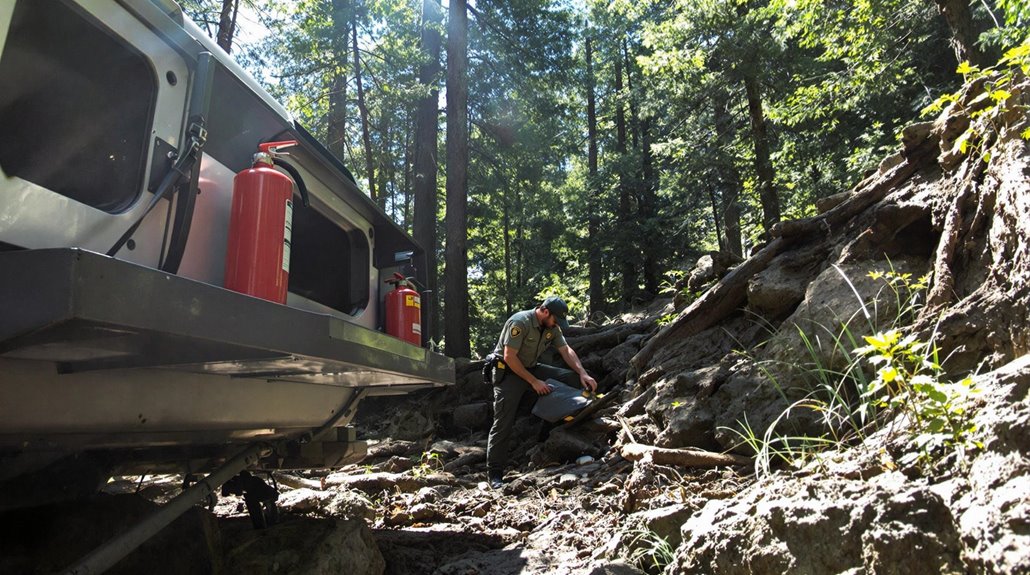
Mitigating wildfire risks through responsible vehicle and equipment use requires both technical acumen and rigorous adherence to preventive measures.
Central to these efforts are thorough vehicle maintenance practices, which include parking on non-flammable, paved surfaces to prevent ignition from hot exhaust systems.
Machinery safety guidelines emphasize the necessity of regular equipment inspections. Utilizing detailed equipment inspection checklists guarantees that spark arrestors are properly installed and fuel lines are free from leaks, reducing potential fire hazards.
Operational protocols further dictate that machinery and tools should not be used on windy days, as airborne sparks can ignite nearby combustible materials.
The availability of fire safety equipment, such as extinguishers and hoses, is critical when operating in wildland regions to promptly address any accidental fires.
Finally, the safe disposal of flammable waste materials, in alignment with local regulations, is essential to prevent inadvertent ignitions and subsequent wildfire outbreaks.
Community Involvement in Fire Prevention
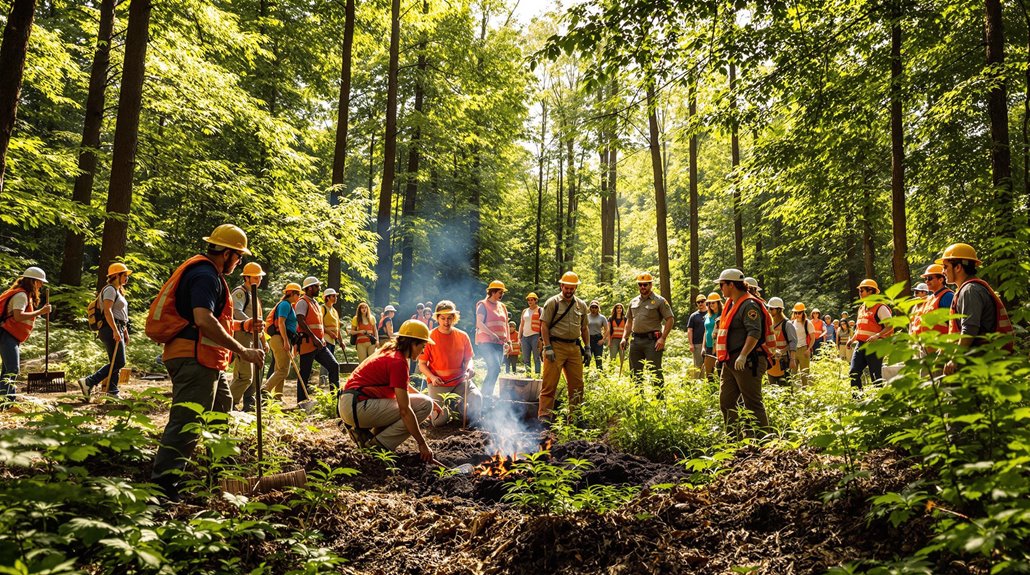
Community involvement in wildfire prevention is integral, with local fire safety initiatives focusing on the implementation of defensible space, fire drills, and compliance with fire safety regulations, thereby mitigating wildfire risks.
Collaborative prevention strategies between municipal authorities and community organizations foster programs that incentivize the adoption of responsible behavior, such as proper campfire management and vigilant reporting of suspicious activities.
These collective efforts enhance not only the efficacy of fire prevention measures but also the overall resilience of communities against fire-related hazards.
Local Fire Safety Initiatives
How do local fire safety initiatives effectively mobilize community involvement to prevent wildfires? By employing community engagement strategies, these initiatives enhance public awareness and action through structured education and collaboration.
Key components include:
- Community Workshops: These serve as platforms to disseminate fire safety resources, informing residents about fire prevention techniques and outdoor safety protocols, thereby mitigating human-induced fire risks.
- Neighborhood Collaboration Initiatives: Local fire agencies partner with communities to establish neighborhood watch programs, promoting vigilance against activities that could potentially ignite wildfires.
- Volunteer Fire Prevention Teams: These teams conduct routine clean-ups to remove flammable materials, creating defensible zones around residential areas.
- Educational Campaigns: Initiatives like Smokey Bear spearhead campaigns educating the public on responsible campfire management and fireworks usage, cultivating a safety-conscious mindset.
Collaborative Prevention Strategies
Integrating community involvement into wildfire prevention strategies markedly enhances risk reduction by leveraging local knowledge and fostering proactive engagement.
Neighborhood initiatives are pivotal, as they enable residents to participate in volunteer campaigns that focus on educating peers regarding fire safety and organizing clean-up efforts to eliminate combustible materials.
Collaboration with local fire departments facilitates more effective resource sharing, optimizing the use of available assets and information.
Regular community meetings serve as a platform for discussing wildfire risks, cultivating collective responsibility, and disseminating innovative prevention strategies.
Additionally, incorporating wildfire prevention elements into neighborhood watch programs empowers residents to detect and report potential fire hazards.
Grant funding supports these endeavors, fostering partnerships between community members and authorities to improve resilience and disaster readiness.
Technological Solutions for Early Detection
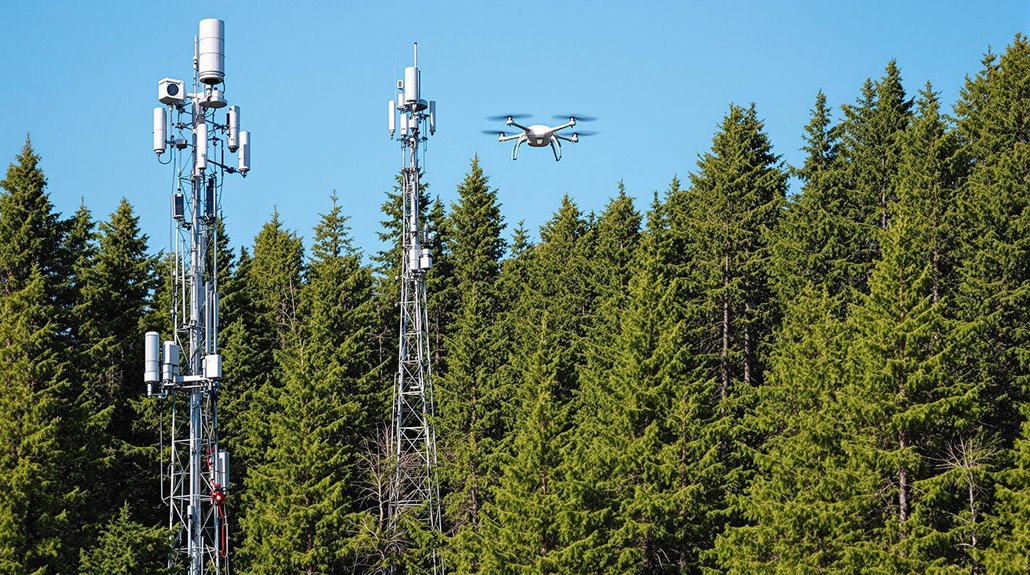
In the domain of wildfire prevention, a multitude of technological solutions are emerging to revolutionize early detection capabilities.
Sensor technology advancements, such as those employed by Dryad Networks Silvanet, utilize solar-powered sensors to monitor microclimate conditions including temperature, humidity, and pressure. These systems are essential in detecting environmental anomalies indicative of potential wildfires.
The integration of wildfire detection algorithms and AI monitoring systems enhances the precision and speed of identifying smoldering fires before they escalate.
- Sensor technology advancements: Solar-powered sensors monitor environmental variables fundamental to early fire detection.
- Wildfire detection algorithms: Algorithms analyze data shifts, providing rapid alerts for emerging threats.
- AI monitoring systems: AI processes data to discern patterns, improving detection accuracy and reducing false alarms.
- Collaborative initiatives: Technological collaboration is crucial for effective risk reduction in susceptible regions.
Quick detection markedly enhances response times, thereby potentially mitigating the scale and impact of wildfires.
Wildfire Defense Services operate across 22 U.S. states and parts of Canada, utilizing advanced technology systems with satellite data and thermal sensors for comprehensive fire monitoring.
Importance of Public Education on Fire Risks
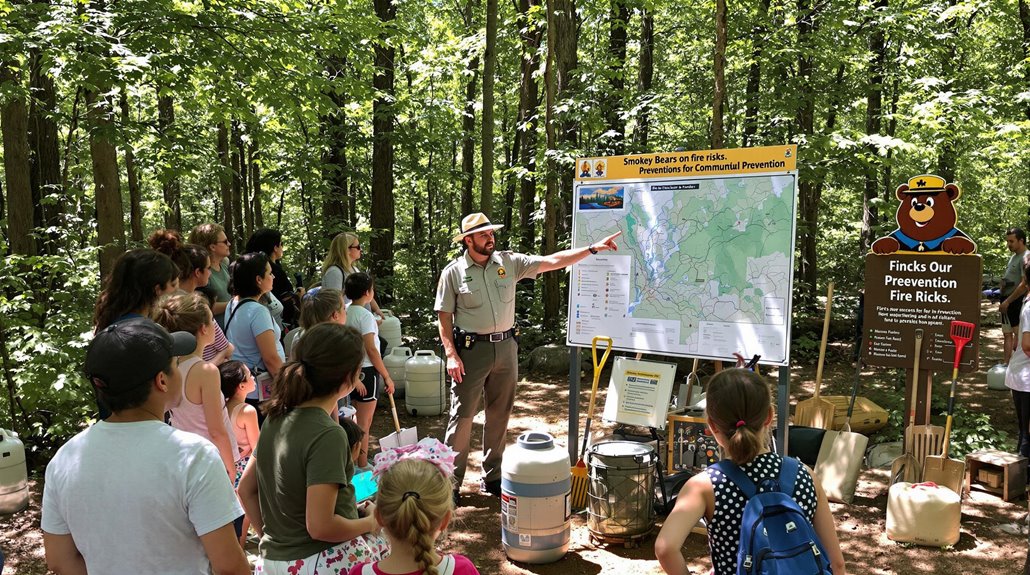
Community awareness programs and fire safety workshops are critical interventions in mitigating anthropogenic wildfire incidents, which account for approximately 90% of wildfires in the United States.
These educational initiatives employ scientific methodologies to instruct the populace on best practices for fire prevention, such as the proper extinguishing of campfires, cautious disposal of flammable materials, and adherence to fire safety regulations.
Creating a defensible space zone around properties is essential knowledge that these programs teach to help protect homes and communities from advancing wildfires.
Community Awareness Programs
Public education programs serve as an essential instrument in mitigating human-induced wildfires, which constitute approximately 90% of all wildfire incidents in the United States.
By emphasizing the community role in fire prevention, educational outreach initiatives can markedly lower wildfire occurrences. Studies highlight the impact of such programs, underscoring their necessity:
- Community Role: Residents are encouraged to create defensible spaces, reducing fire risk.
- Educational Outreach: Informational sessions and workshops enhance awareness of fire safety practices.
- Neighborhood Partnerships: Collaborative efforts between residents and authorities bolster preparedness.
- Distribution of Materials: Local organizations disseminate important fire safety information effectively.
These strategies forge robust neighborhood partnerships, fostering a proactive culture towards fire risk management. Residents should maintain detailed documentation records of all fire prevention measures and property improvements to support potential insurance claims in high-risk areas.
Fire Safety Workshops
Fire safety workshops serve as an essential component in public education efforts addressing wildfire risks.
Through these workshops, participants gain insights into wildfire prevention techniques, focusing on the human activities responsible for approximately 90% of wildfires in the United States, such as unattended campfires and improper disposal of smoking materials.
Community training modules emphasize the importance of fire safety equipment and the creation of defensible spaces, pivotal strategies endorsed by the National Fire Protection Association (NFPA) to protect structures from encroaching flames.
Furthermore, these workshops cultivate a community ethos of preparedness and vigilance, empowering individuals to detect and report suspicious activities.
Such educational initiatives play a critical role in reducing the incidence of human-caused wildfires by fostering informed, proactive communities.
Collaboration With Local Authorities and Organizations
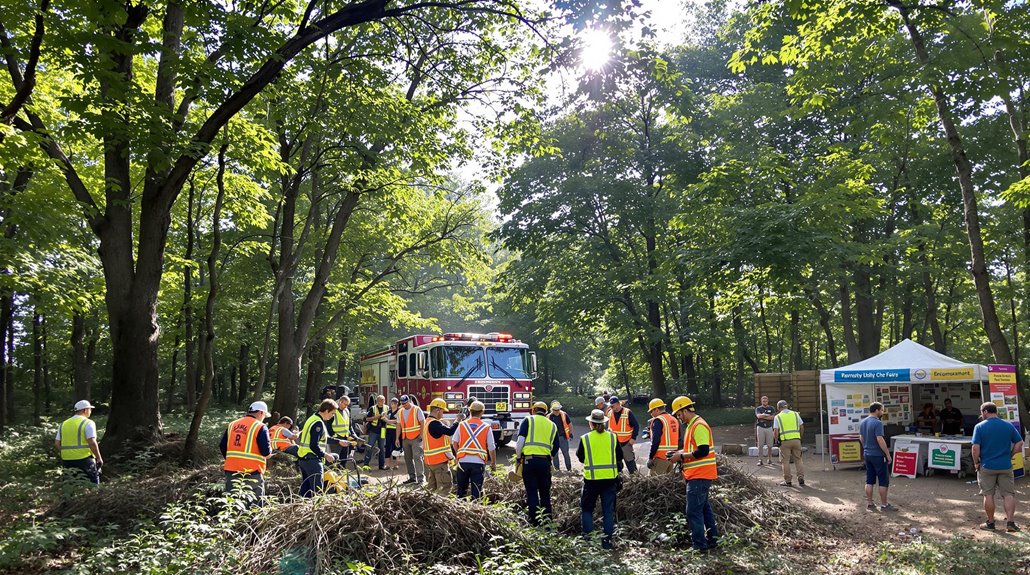
Effective wildfire prevention necessitates strategic collaboration with local authorities and relevant organizations to synergize community initiatives with overarching state and federal fire management protocols. This involves structured community partnerships to enhance disaster response and optimize resource allocation.
Engaging local fire departments in educational outreach provides critical training and resources for residents, bolstering wildfire safety and prevention awareness.
To illustrate the effectiveness of such collaborations, consider:
- Community Partnerships: Establishing robust networks with local organizations to promote fire safety measures.
- Resource Allocation: Strategic distribution of fire management resources to areas of high risk.
- Disaster Response: Improved coordination with local authorities to enhance readiness and response times.
- Regulatory Enforcement: Collaborating with governments to implement and uphold fire regulations, mitigating human-induced wildfires.
Additionally, partnerships with entities like the National Fire Protection Association (NFPA) facilitate the adoption of best practices, such as creating defensible spaces, thereby fostering a culture of preparedness.
With ISO ratings significantly impacting insurance premiums, communities must work together to enhance infrastructure and maintain effective water systems for fire suppression.
Frequently Asked Questions
How Can Most Fires Be Prevented?
Fire safety is enhanced through stringent campfire maintenance, adherence to smoking regulations, and community education. Implementing scientific methods, like vegetation management and fire-resistant materials, aids in mitigating ignition risks, thereby preventing most fires effectively in susceptible regions.
What Are 90% of Wildfires Started By?
Approximately 90% of wildfires originate from human activities, overshadowing natural causes. Scientific analysis emphasizes fire prevention through mitigating factors like unattended campfires, discarded cigarettes, and infrastructure failures, necessitating public education and stricter management protocols for effective risk reduction.
How Can Kids Prevent Forest Fires?
Children, often seen as torchbearers of future change, can ignite awareness in fire safety through extensive outdoor education. By practicing responsible camping, they contribute to reducing ignition sources, thereby playing a pivotal role in forest fire mitigation strategies.
How Can We Protect Wildlife From Wildfires?
Habitat preservation involves integrating fire-resistant flora and establishing wildlife corridors to facilitate safe movement. Scientific management of ecosystems, including strategic vegetation planning, enhances resilience against wildfires, ensuring biodiversity conservation and sustaining ecological balance.
Final Thoughts
In the tapestry of wildfire prevention, akin to Prometheus' eternal vigil, each thread intertwines to shield our ecosystems. By cultivating defensible spaces, practicing safe campfire techniques, and adhering to regulations on fireworks, communities can mitigate ignition sources. Technological advancements in early detection serve as a modern-day Argus, ever-watchful. Public education and collaboration with authorities enhance collective resilience. Consequently, a harmonized approach weaves a robust defense, safeguarding nature's delicate balance from the ravages of uncontrolled fire.
For homeowners facing property damage from wildfires or forest fires, insurance industry professionals and legal experts strongly advise consulting a qualified state-licensed public adjuster to handle insurance claims. Public adjusters work exclusively for policyholders, not insurance companies, serving as dedicated advocates throughout the claims process. These state-licensed professionals help navigate complex insurance policies, identify hidden damages often unknown to policyholders, document losses comprehensively, and negotiate with insurance companies to ensure fair settlements while protecting policyholder rights. By hiring a public adjuster, homeowners can maximize claim payouts, expedite the claims process, and reduce the stress of dealing with insurance companies, allowing them to focus on recovery. Policyholders seeking expert assistance with property damage or loss claims can request a no-obligation free consultation with a Public Claims Adjusters Network (PCAN) member public adjuster through our contact page.

